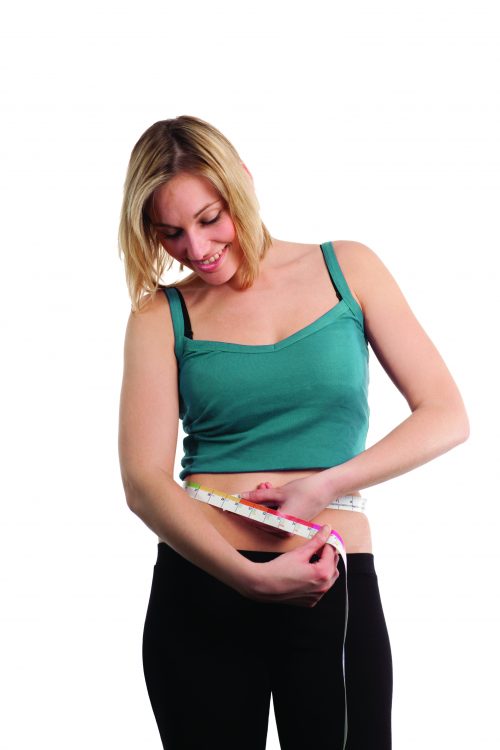
Would you pass a human ‘warrant of fitness’? Knowing some key facts and figures about our health, and how to use them, can help keep us fit and well. By nutritionist Fiona Carruthers.
Waist
Healthy target
For most New Zealand men a healthy waist measurement is a circumference below 94cm, for Kiwi women, below 80cm.
How to measure
Run a measuring tape around your middle, on or just above your belly button. Don’t suck in your stomach!
Why it is important
Carrying excess weight around the middle or abdomen carries higher risk of poorer long-term health than when carried on the hips.
Weight
Healthy target
‘Ideal’ weight depends on height. But the ‘what’ and ‘where’ of weight are also important. If the scales tip over due to well-toned muscle, this indicates better health than if over-burdened by fat. Similarly, excess weight on the hips carries less risk than when it is around the middle or abdomen, nearer vital organs such as the heart.
How to measure
If you have a set of scales, only weigh yourself weekly at most. Scales will tell you if your weight is changing. Your body mass index (BMI) rating (see below) can be a useful guide. Without scales use your clothes as a measure.
Why it is important
Being overweight increases the risk of most modern illnesses – cancer, heart disease, diabetes… the list goes on. In the here and now, carrying too much weight can make day-to-day living harder through breathlessness and aching joints, and inconvenient when clothes no longer fit.
Blood cholesterol
Healthy target
Ideally, LDL cholesterol (or ‘bad cholesterol’ because it deposits fat in the blood) should be less than 2mmol/L, HDL cholesterol (or ‘good cholesterol’ because it takes fat away) should be greater than 1mmol/L and total blood cholesterol less than 4mmol/L. The most important measure is total cholesterol divided by HDL cholesterol: aim for less than 4.0.
How to measure
Blood cholesterol levels are measured with a blood test at your clinic or a diagnostic laboratory. Like a blood glucose level test, it is best done after fasting.
Why it is important
Blood cholesterol levels give an indication of overall heart health and, if high, are a good early signal of potential problems. High cholesterol is one of the risk factors for heart disease.
Blood glucose
Healthy target
Blood sugar, or blood glucose level, varies slightly throughout the day, but the body has well-tuned mechanisms to keep it within a limited range.
How to measure
Blood glucose levels after an overnight fast can be measured in a laboratory to test for diabetes or pre-diabetes. These are usually measured using glycated haemoglobin (HbA1c) which provides a measure of your glucose levels over the previous six to eight weeks. Sometimes, high glucose levels are indicated by an increased thirst, the frequent need to pass urine or excessive tiredness.
Why it is important
Low blood glucose is easier to spot than high blood glucose as the symptoms are more immediate. Glucose fuels the brain so when it falls you can feel light-headed, irritable, tired, unable to concentrate and even faint. High blood glucose usually indicates diabetes, which has serious long-term effects, potentially damaging the eyes, kidney, heart and feet.
Heart rate
Healthy target
A normal adult heart rate (pulse) is somewhere between 60 and 80 beats per minute, averaging 72. Heart rate usually rises with age and is generally lower in athletes or those who are physically fit.
How to measure
Turn one hand over, palm facing upwards. Press the fingers of the other hand into the side of the wrist nearest the thumb until you feel your pulse. Your heart rate is the number of beats felt in a minute, or those felt in 15 seconds multiplied by four.
Why it is important
Having a pulse indicates you’re alive! To improve fitness you can calculate the rate at which you should be ‘working’ when exercising from your heart rate. This is best discussed with a personal fitness trainer or your doctor.
Sleep
Healthy target
Whether you are a morning lark or night owl, most adults need seven to nine hours sleep each day. Newborn babies need up to double this amount, while children need up to 10 hours a day as they head towards their teens.
How to measure
Keep a note of the number of hours you sleep. (Use the chart below.) Less than seven hours a night can lead to sleep deprivation.
Why it is important
A lack of sleep can cause reduced concentration, irritability and difficulty retaining information. These can be overcome by a couple of early nights or well-timed power naps, but sleeping well can also protect us from infections and possibly help control blood pressure. There is also increasing evidence of a link between adequate sleep and maintaining a healthy weight.
Fluid
Healthy target
Drink about 10 cups (2.6L) of fluids each day (men) and 8 cups (2.1L) each day (women) to keep hydrated. This can be made up of any drinks such as water, milk, tea and coffee.
How to measure
Take note of how much you drink or simply measure how much your favourite cup or mug holds and work out roughly how much fluid you drink a day. (Use the chart below.)
Why it is important
The body can’t produce the water it needs each day for digesting food, absorbing nutrients, excreting waste products and regulating body temperature. Needs also differ from day to day depending on climate and level of activity, but drinking only when you feel thirsty is too late – by then you are already mildly dehydrated.
Exercise/activity
Healthy target
Anything is better than nothing. The suggested amount is 30 minutes of ‘moderate intensity activity’ on most days, or at least five days a week. This could be brisk walking, aqua aerobics or golf – activities which lift your heart rate but not enough to stop you talking. Three bouts of 10 minutes count, too. Encourage children to aim for 60 minutes of activity each day.
How to measure
Write down your daily minutes. (Use the chart below.) Keeping visual track can be a great motivator. If you need some extra support or to know what’s safe for you, ask your doctor or practice nurse about Green Prescription.
Why it is important
Being active is important for everyone. It is good for your long and short-term physical and mental health. Being active reduces your risk of heart disease, strokes and some cancers, but it also helps digestion, sleep and feeling good about yourself.
Alcohol intake
What it should be
The maximum recommended number of ‘standard drinks’ a week is 21 for men and 14 for women, with no more than six for men and four for women on any one occasion.
A ‘standard drink’ is equivalent to a 330ml can of beer or a 100ml glass of wine or 30ml of spirits.
How to measure
Keep a tally of how many drinks you have over the next few weeks. (Use the chart below.) Make sure you keep an eye on portions – it’s easy to have more than a ‘standard’ drink in just one glass of wine. Also check out the Alcohol Advisory Council of NZ (ALAC) website, which includes a self-assessment quiz.
Why it is important
Alcohol is an energy source, a stimulant and a poison, so treat it with respect. Taken to excess, alcohol has detrimental effects on the gut, brain, skin and liver. Any potential benefits to the heart are only enjoyed within the recommended limits.
Blood pressure
Healthy target
‘Normal’ blood pressure is around 120/80 although lower is better. ‘High blood pressure’ is considered to be a consistent reading of 140/90 over several weeks. The higher number (systolic) is the pressure exerted when the heart pushes blood out around the body. The lower number (diastolic) indicates the pressure when the heart relaxes and refills with blood.
How to measure
Blood pressure is measured using an inflatable cuff around your upper arm. As the cuff deflates, a stethoscope is used to listen for the sounds of the blood flowing through your arm.
Why it is important
High blood pressure rarely causes any symptoms but has worrying long- term effects. It is the greatest risk factor for heart disease, increasing the chance of heart attacks and strokes. A very common condition in New Zealand, one in seven adults currently takes medication to treat high blood pressure.
Other useful numbers
Body Mass Index (BMI)
BMI is recommended by the Ministry of Health as an estimate for body fatness. BMI is calculated as weight (kg) divided by height (m2). It is a less accurate indicator for some ethnic groups, older people and those who are highly muscular (muscle weighs heavier than fat). With these limitations, waist measurement is becoming a popular secondary measure.
Family health history
Some conditions run in families so know your family’s health history. Additional screening may be offered to those with a family history of certain cancer types or heart disease, for example.
Medications and allergies
Know exactly what medications you are taking. ‘Small pink ones’ won’t help paramedics help you in an emergency. And tell the doctor or nurse if you are allergic to any medications.
Blood type
Blood type is determined by the substances found on the surface of red blood cells. It is inherited from your parents. About 50 per cent of New Zealanders are Type O, and a fifth of these Type O negative. Type O negative blood can be given to anyone in an emergency.
The chart
Photocopy and fill in this chart each week to keep track of your numbers.
| WEEK 1 | M | T | W | T | F | S | S |
| Number of standard alcoholic drinks each day | |||||||
| Number of hours’ sleep a night | |||||||
| Minutes of exercise each day | |||||||
| Number of cups of fluid consumed each day |
| WEEK 2 | M | T | W | T | F | S | S |
| Number of standard alcoholic drinks each day | |||||||
| Number of hours’ sleep a night | |||||||
| Minutes of exercise each day | |||||||
| Number of cups of fluid consumed each day |
What to do if the numbers are high
As well as knowing your numbers, know how to use them. If you get less-than-positive results when your numbers are tested, talk to your doctor. Be prepared to make some changes and try not to worry – because worrying may make them worse! Stress raises heart rate, blood pressure and blood cholesterol and may stop you sleeping. So, set yourself some goals, seek support if you need it and aim for gradual improvement.
www.healthyfood.com










